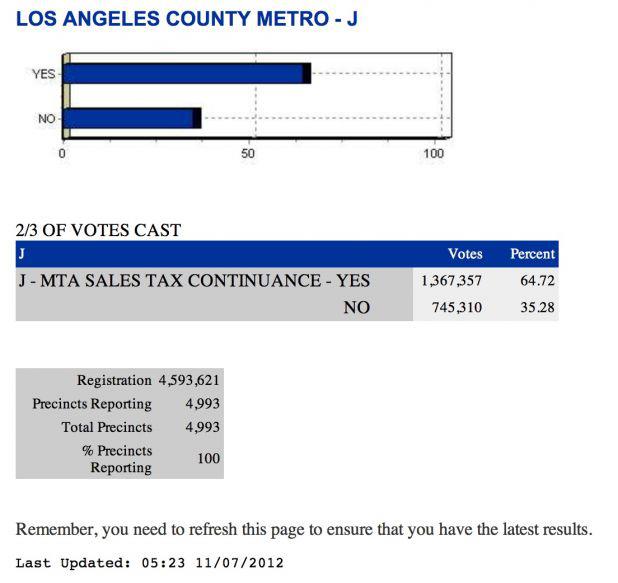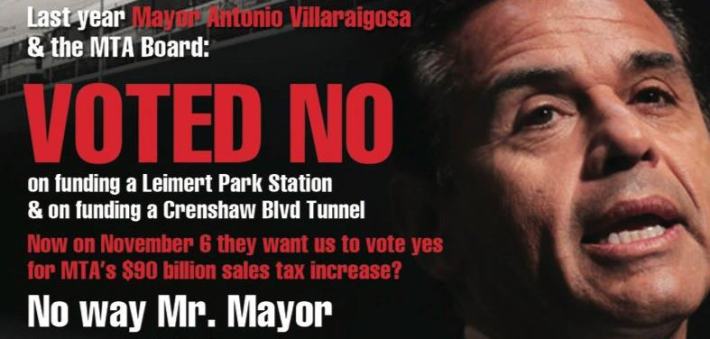Measure J’s “Rejection” Was NOT an Anti-Transit Vote
11:14 AM PST on November 7, 2012

Maybe a two-thirds local threshold is just too high a bar to cross, maybe the No on J Campaign did its job too well, maybe voter turnout for the top of the ticket was too low. Whatever the reason, Measure J received "only" 64.7% of the vote last night, a full 1.95% short of the two-thirds threshold it needed to pass. "Only in California is 65% a defeat instead of a landslide victory," wrote Denny Zane on his Facebook page. "...and that has to change."
Measure J was a proposed extension of the 2008 Measure R sales tax that dedicated a half cent of L.A. County sales tax to transportation projects. Measure J would have extended the tax from 2039 t0 2069 allowing Metro to bond against the new revenue and "build 30 years of transit projects in 10 years." The Measure needed the support of two-third of L.A. County voters in yesterday's vote to pass.
There are many lessons that can be inferred from last night's results, none of which point to a lack of support for transit expansion by L.A. County voters. We will conduct a better analysis after the election results are broken down geographically.
First, credit needs to be given to the No on J Campaign. On a shoestring budget, the group pulled together a county-wide campaign of opposition and planted stories and opinion pieces in newspapers and media outlets both large and small. The campaign also ran a grass roots effort of door knocking, phone banking and handing out literature on buses. Compare the No on J Campaign to the Bus Riders Union's muddled "No on the 6" campaign in 2008 and their improved organization could be one reason for the small tilt in support.
For anyone who believes the Bus Riders Union is a political relic, yesterday's win marks the second time in two years the group has expanded their coalition and pulled off a victory. Working with the Crenshaw Subway Coalition, the Beverly Hills Unified School District and the No on 710 Coalition, the BRU is showing it knows how to work with groups outside their traditional allies to pick up headlines grabbing victories. The first time would be the stopping Westside homeowners groups from exempting the entire Westside from the Wilshire Bus Rapid Transit project.
Or, as the Crenshaw Subway Coalition put it on Facebook this morning, "How do you like dem apples?"
But the organized campaign against Measure J wasn't an anti-transit one. If anything, it was an anti-highway, anti-gentrification, and pro-transit operations campaign that included an element that is also opposed to the Westside Subway. The elected officials opposed to the tax extension complained that not enough was being spent on transit in the areas they represent.

It's an article of faith among Metro Board Members and many in the media that ballot measures need to have freeway funding to pass, but most of the opposition to Measure J was because not enough was being spent on transit projects and operations. In the San Gabriel Valley politicians were clambering for more funds for the Gold Line.
Conversely, one of the loudest groups opposing Measure J was doing so because of fears that the tax money would be spent to extend the 710 freeway, either by tunnel or highway, through the San Gabriel Valley.
In South L.A., they wanted more money for the Crenshaw Line. In the San Fernando Valley they wondered why support a transit tax after the Orange Line was built. In the San Gabriel Valley the No on 710 Coalition was fighting funds for the Big Dig. There was no opposition arguing for an 11th lane for the I-405 through the Sepulveda Pass or a new carpool lane on the I-10. The only opposition to Measure J that is also opposed to a transit project and used that as a reason to fight Measure J was the Beverly Hills Unified School District, and they maintain they would support the project if there were a route that did not go under Beverly Hills High School.
Some proponents look at the nearly 65% of voters that voted for Measure J as a moral victory. After all, Proposition 30 barely received 50% of the vote and is widely being touted as proof that Californians support public education. If the voter threshold were lower, even down to what passes as a "Super Majority" in legislative houses at 60%, we would be writing a different piece today.
In the coming weeks, armchair quarterbacks will doubtless attack the Yes on J Campaign and the text of the Measure itself. Most of the criticisms of the Yes on J campaign is speculation at this point as we don't know how their millions of dollars were spent outside of the paid media campaign. Given the huge funding advantage the Yes on J campaign had, it out fundraised the opposition campaign by $2,000,000 to $5,000 in the most recent campaign filings, many expected the Yes campaign to be more visible.
One example of the Campaign's failure is that the difference between a "sales tax extension" and a "sales tax increase" was lost on many people. For example, when NBC 4 held a forum on Measure J on its Sunday morning talk show, neither the host nor the Measure J proponent, a representative from the Chamber of Commerce corrected the Measure J opponent who called Measure J a "new tax." In fact, the host actually began repeating the incorrect claim.
Depending on who you talk to, the language of Measure J either went too far or not far enough.
Fiscal conservatives railed against Measure J because it extended the sales tax until 2069 or "until my children are receiving social security" as one Mother of grade-school aged children posted on Facebook. Conversely many opponents were angry the new tax didn't actually fund anything new. While the Los Angeles County Bicycle Coalition and Los Angeles Walks both backed the measure, some on social media grumbled that the tax extension didn't actually guarantee new funds for bicycle or pedestrian projects. We've already discussed the opposition by some in South L.A. because the Crenshaw Line as approved by the Metro Board runs at-grade for a certain stretch and does not have a "Leimert Park Station."
Of course, there might not be any lesson to be learned at all as far as transit and L.A. County voter opinion is concerned.
In 2008, 3,001,783 were cast in the Measure R vote. This year, only 2,112,667 did. It could well be that there was nothing the pro-Measure J forces could do without bigger ticket races drawing in casual voters as they did four years ago.
Stay in touch
Sign up for our free newsletter
More from Streetsblog Los Angeles
Metro Board Funds Free Student Transit Pass Program through July 2025
Metro student free passes funded another year - plus other updates from today's Metro board meeting
Eyes on the Street: New Lincoln Park Avenue Bike Lanes
The recently installed 1.25-mile long bikeway spans Lincoln Park Avenue, Flora Avenue, and Sierra Street - it's arguably the first new bike facility of the Measure HLA era




